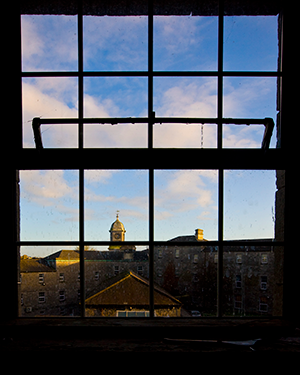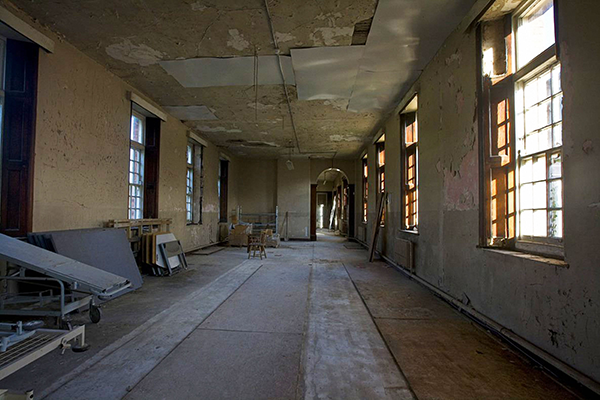ST JOSEPH’S HOSPITAL, LIMERICK
Published in Issue 3 (May/June 2022), Volume 30By Jacqui Hayes

Above: On the inside looking out—in oral histories staff reflect that they were in effect locked up and became institutionalised themselves. (Limerick Archives)
St Joseph’s Hospital was founded as Limerick District Lunatic Asylum in 1827 with accommodation for 150 patients, a number almost immediately exceeded. The minute books in the archives document that from the earliest days overcrowding was a constant problem. In 1874 the inspectors of lunatic asylums reported that ‘from the statistics before us we deduce that there is considerably more of genuine lunacy in the Limerick District than is to be found elsewhere in Ireland, and that types of the malady there are more variable and pronounced’. By 1940 the hospital held 885 patients and this was mirrored nationally in other mental hospitals. A 1966 landmark report noted: ‘In Ireland, approximately 7.3 psychiatric beds were provided in 1961 per 1,000 of the population; this rate appears to be the highest in the world … about one in every seventy of our people above the age of 24 years is in a mental hospital’.
Very few committal forms survive from before the 1880s but from 1880 onwards they are almost intact, providing an excellent record for the causes and methods of admission. The relative ease with which individuals could be admitted to the asylum was a contributing factor to the consistent rise in asylum numbers. Under the 1838 Dangerous Lunatics Act, most people with mental illness were classified as ‘dangerous lunatics’—criminals—in order to gain easy admission to the asylum. The hospital could not refuse to take the patient and maintenance costs were borne by the hospital. From 1868 an accusation of insanity made in front of two justices of the peace, with an examination by a physician, was sufficient for committal. A randomly selected committal form in the archive for June 1895 notes that Miss M was brought before two justices of the peace for assaulting her brother with stones. The probable ‘cause of derangement’ was noted as ‘family trouble’. Miss M remained a patient in the hospital until her death in 1918.
Admission registers survive from 1880 to 1957. In 1892 the admission registers show that of the 56 patients admitted during that year 37 subsequently did not leave and died in the institution. Approximately one third were discharged within a year of admission. In the same year the majority of admissions were male, at a ratio of 32 males to 24 females, ‘mania’ being by far the most common cause of admission. Without any surviving casebooks it is impossible to know the full history of the patients’ care.
While care was custodial, it was rarely permitted to involve cruelty, and the death of a patient was taken very seriously. There was a major controversy in 1872 when a patient died after being submersed in a bath. Submersion in baths had been introduced in many asylums as a curative method but became mainly used as a method of punishment. The incident led to a sworn public investigation and the dismissal of the resident medical superintendent, Dr Robert Fitzgerald.
The annual report of the Limerick District Lunatic Asylum for 1900 provides a snapshot of life in the institution. Dr Edward O’Neill, the resident medical superintendent, notes ‘how the death rate was exceptionally high … The most frequent cause of deaths among the insane is phthisis (tuberculosis) and that this dire disease should be so, is little to be wondered at, as our Asylums are not adapted for the isolation and treatment of the disease.’
The development of a farm on the grounds of the asylum combined with all the other trades to make the asylum self-sufficient, a ‘total’ institution. The hospital had its own bakery, laundry, cobbler, butcher, tailors, upholsterers and permanent tradesmen to maintain the buildings, including masons, carpenters, groundsmen and painters. These provided occupation for the patients, and up to the 1970s the hospital fed its c. 900 patients and 400 staff mainly from its own farm produce.
Until the 1950s the hospital was heavily segregated: ‘Most wards were locked. Male admissions 3, 9, and 10 were open, but other than that almost all other wards were locked.’ The building was heated by open turf fires until the first turf-fired central heating was introduced. Storage of turf, large amounts of food and a high concentration of people meant that rats and cockroaches were difficult to control until the advent of modern pesticides. Staff were obliged to ‘live in’ until they qualified as psychiatric nurses up until the late 1960s. In oral histories staff reflect that they were in effect locked up and became institutionalised themselves.

Above: A disused former ward—in 1966 a commission of inquiry report was critical of these large institutions and recommended their replacement with a community-based model. (Limerick Archives)
The 1945 Mental Treatment Act provided for a professional nursing structure and an admission procedure based on medical criteria. In the following decades, the introduction of drugs and ‘active’ treatment was revolutionary. Wards that had been ‘very disturbed, noisy, distressing places’ became much calmer, and the use of physical restraints became a thing of the past. Gradually staff, who were responsible for everything from washing the windows to shaving the patients, became trained as psychiatric nurses. Although many of these treatments have since been discredited, such as the use of insulin therapy and ECT (electric convulsive therapy) without anaesthetic, they did represent efforts to treat mental illness as a curable medical condition.
A 1966 commission of inquiry report was critical of these large institutions and recommended their replacement with a community-based model. It emphasised the importance of preventing institutionalisation. ‘In total institutions people are … stripped of their independence because everybody feels the right thing to do, even the most benevolent of institutions, people feel that it is easier to do something for somebody than to teach them to do it themselves’. In the late 1960s, nurses agitated for better conditions for themselves and patients. Reform gathered pace in the 1980s, when practical efforts were made to deinstitutionalise patients: ‘Butter, milk and sugar were put on dining tables and patients had a choice. Before that, the bread came already buttered and the tea had milk and sugar.’
The collection has been transferred to Limerick Archives on long-term loan. All requests for access require the prior sanction of the HSE.
Jacqui Hayes is an archivist with Limerick City and County Council.
















